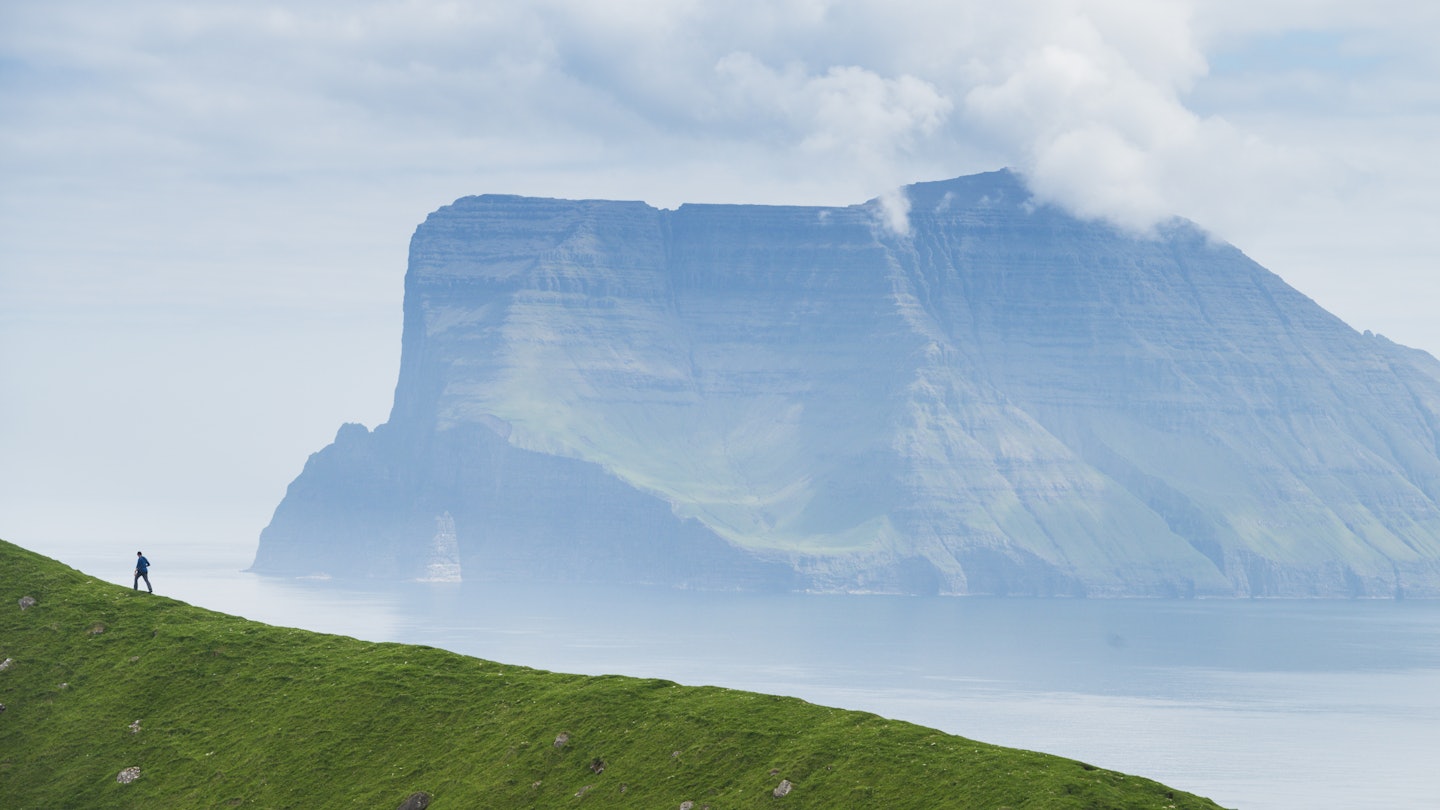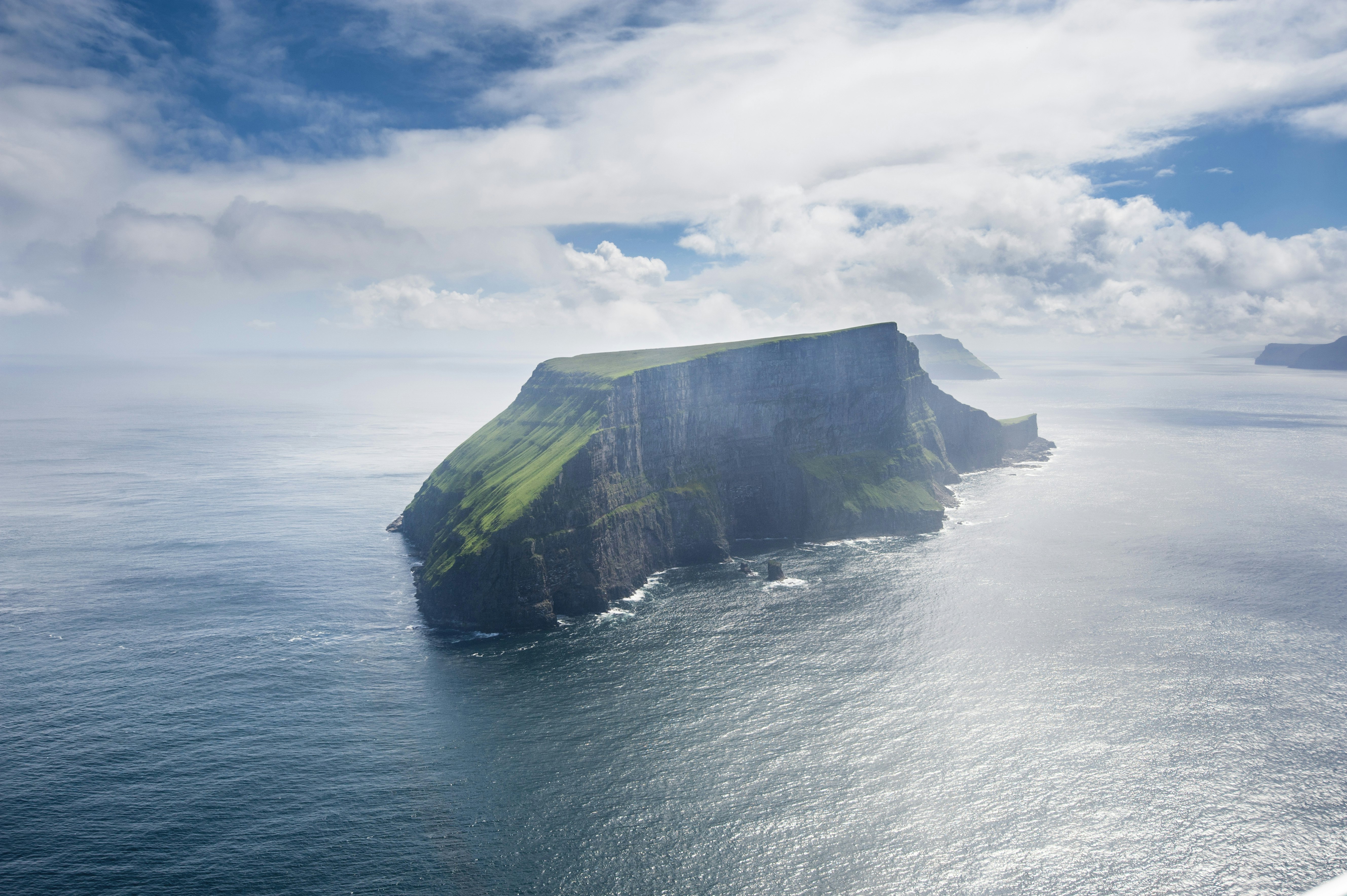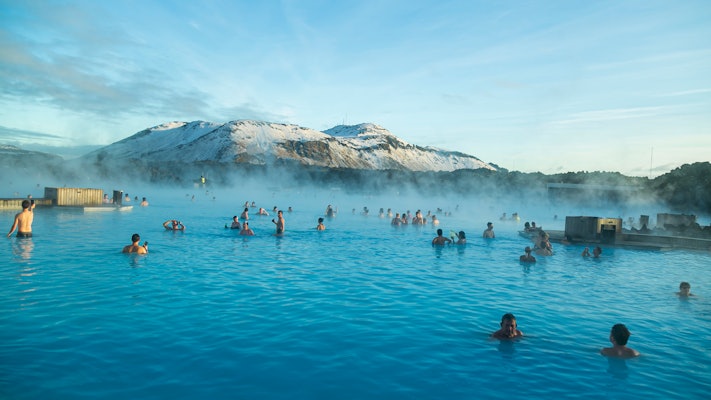Want to extend your trip to Europe’s Nordic region? Here are 5 ways to do it

Feb 2, 2025 • 11 min read

Spend a weekend in the unspoiled wilderness of the Faroe Islands. Justin Foulkes for Lonely Planet
Cruising past dramatic fjords in Norway, spotting adorable Atlantic puffins in the Faroe Islands, swimming in famously blue thermal waters in Iceland – big adventures don’t always require lengthy trips. In fact, in Europe’s Nordic region, it’s easy to combine a few epic adventures into one big experience, or to tack one of these onto your longer vacation.
Next time you find yourself in Northern Europe, consider these five ways to linger a little longer.

1. Set sail for the Faroe Islands
Halfway between Scotland and Iceland, almost lost in the middle of the Atlantic Ocean, the Faroe Islands appeared a few years ago on the radar of adventurous travelers in search of unspoiled wilderness. This Danish territory has just 52,000 human inhabitants – plus thousands of sheep grazing its immense green expanses.
Where to stay: If you only have a few days, base yourself in the capital Tórshavn. Havgrím Seaside Hotel 1948 is a classy boutique property with views of the island of Nólsoy, as well as excellent service and a superb breakfast.
How to get around: The only airport is in Vágar. Tórshavn is 56km (35 miles) from there and best reached by taxi or rental car (book early). Regular buses connect the main towns and tourist spots, but they take time. Ferries run to nine islands, and helicopters are an important transport link for small island communities. Driving is the most convenient way to explore, but car hire can be pricey. The larger central islands are linked by subsea tunnels, and only a few places can’t be reached within an hour from the capital.
When to visit: Plan your visit for the period from June to August and bring warm clothing – the weather is not always predictable or kind. The islands’ music scene is rooted in ancient traditions when storytelling and song were the only means of preserving the Faroese language. Summartónar, held every year between May and August, presents over 150 concerts, performed mainly by local musicians.




What to do
Horseback riding on Streymoy
On the island of Streymoy, the largest and most populous of the archipelago, horse-riding excursions for all levels are organized from Tórshavn. Some companies offer rides on a Faroese pony. In the north of Streymoy, Tjørnuvík, also known for its typical colorful houses, and Saksun, where access is guarded by a lake encircled by mountains, are two hamlets worth a stop for their pastoral charm and peaceful atmosphere.
Discover the Vestmanna cliffs by the sea
From the port of Vestmanna on the island of Streymoy, take a boat trip west to Vestmannabjørgini. You’ll sail along steep cliffs and, weather permitting, explore rocky inlets, learning about the different species of birds that nest in the hard-to-reach nooks and crannies of this impressive natural setting.
Meet the Mykines puffin
Only 20 or so inhabitants live permanently on the island of Mykines, just a one-hour by ferry from Sorvágur on Vágarbut, where you’ll find a wild and friendly fauna that outnumbers the people and attracts many bird-watchers. This is the home of the Atlantic puffin, a protected species that should be observed from a safe distance so as not to disturb its natural habitat. Don’t miss a visit to the tiny village of Mykines, before exploring further on foot and taking the Atlantic Bridge to the islet of Mykineshólmur, where you’ll find a lighthouse in a location just begging to be photographed.

2. Travel between land and sea in Bohuslän
The Swedish province of Bohuslän is perfect if you want outdoor action in beautiful surroundings. Nicknamed the “sunny coast” because of its mild climate, it’s along the region’s Baltic Sea shoreline, stacked with natural gems: pink granite islands, reefs, meadows and sandy beaches, fishing villages full of brightly painted wooden huts and secluded resorts. Sweden’s second-largest conurbation, Gothenburg, is the point of entry to this attractive area. Spend a day taking in the culture of one of its many museums and admiring the city’s street art before heading north to enjoy Bohuslän’s coastal attractions.
Where to stay: With its many amenities, Gothenburg’s city center is the ideal place to stay, especially around the cathedral and the Stora HamnKanalen canal.
How to get around: Gothenburg Airport has direct flights to around 30 cities across Europe. Ferries and trains connect the city to Germany and Denmark. The local bus network is well-developed, and most destinations are easy to reach by public transport.
When to go: Among Gothernburg’s top events is Way Out West, a major pop and electronic music festival in August that attracts crowds of visitors. In September, the Bokmässan attracts bibliophiles to Scandinavia’s most important literary event. The city also shines brightly in December with Christmas markets and celebrations in honor of St Lucia.


What to do
Take a trip to Brännö Island
Brännö, off the coast of Gothenburg, is a top destination for a day out among the region’s islands. A welcome tranquillity emanates from this car-free piece of land, where wooded hills fade into the choppy sea. Take the one-hour ferry from Gothenburg, bringing a bike along if you want to venture out on two wheels.
Canoeing in the Vättlefjäll Nature Reserve
Northeast of Gothenburg, the splendid Vättlefjäll Nature Reserve is a playground for outdoor enthusiasts. Made up of moorlands, forests, hills and lakes linked by a network of canals, it’s home to exceptional flora and fauna. Your stay here might include swimming, hiking, barbecuing, kayaking or even Canadian canoeing – and all this is just 20 minutes by car from Gothenburg (or 30 minutes by bus).
Life in small town Marstrand
In the middle of a natural setting of granite rock and verdant forest, quaint Marstrand attracts many summer visitors who come to walk, swim or go boating. Home to age-old maritime traditions, the small town is split in two by an arm of the sea: a ferry takes you to the western half of town and sturdy Carlsten Fort, an ancient citadel built to defend Bohuslän when it became a Swedish province in 1658. The town is a 45-minute drive northwest of Gothenburg.

3. Experience the drama of the fjords in Western Norway
There’s no better place to spend a memorable weekend than in the maritime maze of Norway’s western fjords, whether you’re on foot, bike, kayak or boat. Along scenic roads linking the highlights of this dazzling Scandinavian region, you’ll pass grinding glaciers, azure lakes, perpetually snowcapped mountains, orchards in bloom on spring days and a rough coastline sprinkled with islands. At the heart of this enchanting picture lies Bergen, a charming, laid-back city whose pretty narrow streets, multicolored houses and old port, bordered by the unmissable Bryggen wharf lined with picturesque wooden boathouses, are the stuff that holiday dreams are made of.
Where to stay: Bergen’s Bryggen district, adjacent to the old harbor, is home to a number of attractive accommodation options in the city’s most scenic spot, such as the Radisson Blu Royal Bergen.
How to get around: Bergen is easily reached by flights from dozens of international destinations. The city center is walkable, with most major attractions in a relatively compact area. City buses operated by Skyss connect downtown with destinations throughout the metro area and are the most common way to get around. Bybanen, the city’s light rail, runs between downtown and Bergen Airport, with a spur line to Fyllingsdalen Terminal.
When to go: In May, the Bergen International Festival puts on a variety of concerts, plays and exhibitions. Norway’s Constitution Day on May 17 is also a major event, with brass bands and parades in traditional costume. Gourmets will prefer to visit in September for the Matfestival, a food and cider festival featuring local produce.




What to do
Explore Hardangerfjord
You’ll fall hard for Hardangerfjord, a stunningly beautiful inlet with emerald waters surrounded by high mountains; sparkling glaciers; waterfalls; woods; orchards full of strawberries, plums and apples; and quaint villages. From Bergen, take the bus to Norheimsund and then the ferry that sails through the heart of Hardangerfjord to Eidfjord, a village at the bottom of a vast glacial valley.
Hiking on Mt Fløyen
From downtown Bergen, the Fløibanen cable car takes you up Mt Fløyen, one of seven mountains rising above the city, in just a few minutes. A number of walking trails at the top offer splendid views, including a route to nearby Mt Ulriken, another natural viewpoint overlooking Bergen and the fjords (three-hour walk). To save retracing your steps, the Ulriksbanen cable car can take you back down to the Bergen area.
Take a trip to Sognefjord
At 204km (127 miles) long, Sognefjord is Norway’s largest and deserves a full day to appreciate it. From Bergen, the Sognefjord in a Nutshell tour is offered from May to September by Fjord Tours. The boat cruises from the city and then along the length of the fjord, with its turquoise waters and snowcapped mountains, all the way to the village of Flåm, before you return to the city by train along a scenic railway line.

4. Find Finnish cool around Helsinki
A port city and capital of a country where water is everywhere, Helsinki’s location on the Baltic Sea couldn’t be more apt. The twists and turns of its ragged coastline conceal numerous bays, coves and hundreds of islands worth exploring, including Suomenlinna with its imposing fortress. And the city itself has plenty of land-based appeal, too. In addition to splendid Art Nouveau architecture, heritage museums and century-old cafes and restaurants, there’s a cool contemporary artistic culture, with more than 50 museums and galleries.
Where to stay: Accommodation options are dominated by chain hotels, but there are a few boutique and design options, plus a campsite. Central Hotel Klaus K has cool minimalist decor. On Suomenlinna, Hostel Suomenlinna makes an excellent base.
How to get around: Helsinki is extremely well connected to cities around the world. For a different way to arrive, take the ferry from Tallinn (Estonia) or Stockholm (Sweden). Once there, the best way to explore is on foot, as the city is almost completely flat. Helsinki's retro-style orange metros take passengers from one side of the city to the other in a matter of minutes. Trams are also a good option to ease the strain on your feet.
When to go: Events to plan a trip around include September’s Helsinki Design Week, the largest design festival in the Nordic countries; and St John’s Day in June, celebrated on the longest day of the year.


What to do
Shop in the Design District
Helsinki is an international capital of design, from ready-to-wear to the latest furniture and home decor. The Design District is home to hundreds of boutiques, workshops and galleries, including stalwart Artek and relative newcomer Lokal. Round off your design day out with a visit to the Design Museum, which traces the origins of Finnish design, its links with nature and its continuing evolution.
Explore the island fortress of Suomenlinna
Suomenlinna, the "Fortress of Finland," is a UNESCO World Heritage Site on an island just southeast of Helsinki. Built by the Swedes in the 18th century, it covers an archipelago of six islands linked by bridges. Ferries run between downtown Helsinki and Suomenlinna, where you can visit museums, old casemates and fortifications and a WWII submarine.
A nature trip in Nuuksio National Park
Close enough to Helsinki for a half-day getaway, Nuuksio National Park opens the doors to the wonders of Finland’s nature. Two trails offer walks through glacier-eroded wooded valleys, home to elk, lynx and nocturnal flying squirrels. You can stay on-site, too, in one of the campsites, chalets or refuges.

5. Icelandic adventures around Reykjavik
With a coastline of bays and peninsulas, vast stretches of wilderness and snowcapped mountains, Reykjavík is a small city built on a human scale in the grandest of natural surroundings. Even with limited time, the Icelandic capital and the region around it offer a satisfying taster of this fascinating land of fire and ice. With its busy Laugavegur shopping street, huge, rocket-ship-like Hallgrímskirkja, picturesque harbor, beloved Lake Tjörnin, remarkable street art and colorful old houses, "Smokey Bay," as the city's name translates, is an inviting, compact place to stroll, tap into nightlife and base yourself to see highlights along the famous Golden Circle.
Where to stay: Iceland’s capital offers a wide range of accommodation, from budget hostels to luxury hotels. If you want to sleep right in the heart of the city, check that the address shows postcode 101. Hótel Borg, an Art Deco luxury hotel on Reykjavík’s main square, ran Iceland’s only legal pub in the 1940s.
How to get around: Many of the most popular sights can be reached by public transport or organized tour. Rent a car to go further afield.
When to go: In August, Reykjavík shines during Culture Night, which highlights many cultural and artistic venues, while in November the city rocks to the rhythms of Iceland Airwaves, a major contemporary music festival showcasing local and international acts.




What to do
Swim in the waters of the Blue Lagoon
An essential stop on the outskirts of Reykjavík, the Blue Lagoon is renowned the world over for the benefits of its thermal waters, rich in algae, silica mud and mineral salts. Nestled in a dark, captivating rocky landscape, this open-air wellness center is the prime place to recharge your batteries in water at 38°C (100°F), whatever the outside temperature.
Discover the jewels of the Golden Circle
The Golden Circle is a 300km (186-mile) itinerary checking off some of Iceland’s most magical spots. Gasp at the deafening roar of Gullfoss waterfall, wait expectantly at Geysir geothermal site for the impressive Strokkur geyser to shoot into the air (every 4-10 minutes), and walk between continents at þingvellir National Park, full of historic significance and where two tectonic plates meet.
Hunt the Northern Lights
What could be more enchanting than seeing the mesmerizing Northern Lights in the heart of unspoiled nature on a clear, cold winter’s night? Many tour operators run aurora-borealis-seeking trips from Reykjavík between September and April, but you can also try to look on your own – consult the en.vedur.is website.
This article was adapted from Lonely Planet's 100 Weekends in Europe.



